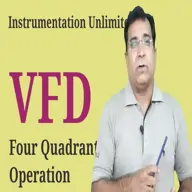Variable Frequency Drive Fundamental and Its Applications

Language
English
82 Views
Share
Access anytime
36 Min
This course format through pre-recorded video. You can buy and watch it to learn at any time.
FREE
videos

FREE
Why do you enroll
Key topics covered
Course details
Course tags
Course content
Why do you enroll
Once you join and go through this course, your fundamentals will be cleared on VFDs and its application and you will be able to specify any kind of drive for procurement and decide its utility on industrial equipments on how to select VFD drive to achieve maximum productivity and efficiency.
Key topics covered
Topics will be covered as hereunder :
1. VFDs Control Methods
2. VFDs for Power Saving
3. VFDs Four Quardrant Operation
4. VFDs Derating
Course Details
Variable Frequency Drive: Fundamentals and Applications
A Variable Frequency Drive (VFD) is a critical technology used to control the speed, torque, and direction of an electric motor by adjusting the frequency and voltage of the power supplied to the motor. VFDs are crucial in various industrial and commercial applications for enhancing the performance, energy efficiency, and reliability of systems that rely on electric motors.
Fundamentals of Variable Frequency Drive (VFD):
A VFD works by altering the input electrical parameters (frequency and voltage) to the motor, allowing the motor to operate at different speeds and providing fine control over the motor's behavior. This is done through three main components:
1. Rectifier (AC-DC Conversion):
2. DC Link (DC Bus):
3. Inverter (DC-AC Conversion):
The ability to adjust both the frequency and voltage allows the VFD to precisely control motor speed and torque. The frequency determines the speed of the motor, while the voltage controls the torque output. By altering these parameters, the VFD enables motors to run at optimal speeds for specific applications, improving efficiency and reducing wear.
Types of VFDs:
Scalar Drives: These drives regulate the motor's speed based on simple voltage-to-frequency ratios and are generally more affordable, although they do not provide advanced features like vector control or sensorless control.
Vector Drives (Field-Oriented Control):** These drives offer more precise control by managing the motor's flux and torque separately. Vector control is suitable for high-performance applications requiring tight speed regulation and rapid dynamic response.
Applications of Using a VFD
1. Energy Savings: One of the primary advantages of a VFD is the reduction in energy consumption. By controlling the speed of the motor, the VFD ensures that the motor is running only as fast as needed for a particular task. In applications like pumps, fans, and conveyors, reducing the speed of the motor can lead to significant energy savings. The relationship between motor speed and energy consumption is often non-linear, meaning that even small reductions in speed can result in substantial energy savings.
2. Improved Process Control:VFDs offer precise control over motor speed, which is essential in applications where varying loads need to be handled. This capability enhances process control in systems such as material handling, HVAC systems, and pumping stations.
3. Reduced Mechanical Stress and Wear: By allowing motors to start and stop gradually, VFDs reduce mechanical stress during startup and shutdown. This extends the lifespan of both the motor and associated equipment, reducing maintenance costs and downtime.
4. Improved Power Factor:VFDs can improve the power factor of an electrical system by controlling the reactive power drawn by motors. This helps reduce the demand charges from utility providers, further contributing to energy savings.
5. Noise Reduction: By operating at lower speeds, VFDs can also reduce the noise levels in equipment like fans and pumps, making them more suitable for environments where noise control is important.
6. Reduced Harmonic Distortion: Modern VFDs, especially those using PWM techniques, can minimize harmonic distortion in the power supply, improving the overall power quality and reducing the need for costly filtering equipment.
Conclusion:
Variable Frequency Drives (VFDs) are integral to modern industrial and commercial systems, providing significant benefits in terms of energy efficiency, process control, and cost savings. By offering precise motor control, VFDs enhance the operation of pumps, fans, conveyors, and many other systems, improving productivity while reducing operational costs. The applications of VFDs span across multiple industries, from HVAC systems and material handling to manufacturing, pumping, and renewable energy sectors. As energy efficiency and automation continue to be prioritized in industrial and commercial sectors, the role of VFDs will only grow, making them a fundamental component of energy-saving strategies and advanced motor control.

Show more
Course tags
Industry domains :
Manufacturing , Energy & Utilities , Electronics & Instrumentation
Engineering Disciplines :
Course content
1
VFDs and Its Control Methods :
Scalar Control and Vector Control Mode are the two VFD Control Modes deployed in various applications encountered in industries which ensures better efficiency of motor and power saving as well. VFDs have been there in industries for quite a long time for control and power-saving purposes. Right control methods selection and configuration of VFDs ensure efficient operation of motors and promise reduced downtime. This video explains control methods employed in various applications found in any industry.
2
VFD for Power Saving :
VFD has been long known as power saving or energy-saving device apart from speed control and torque control device. This Video lets you know the various power-saving applications on which VFD can save energy and reduces power consumption in industries. Variable loads found in industries exhibit considerable saving sources. Eliminating use of dampers and control valves and installing VFD on variable loads can save power requirements. Video explains the fundamentals behind the selection of loads for power saving and how to proceed further with VFD installation.
3
VFD Four Quadrant Operation :
This video describes the VFD four quadrant operation of an electric motor by VFD, and the motor braking system applied in various applications. In industries mostly VFD drive applications are found to be operating in 1st Quadrant motoring applications and a few places in 3rd Quadrant applications. But due to the nature of the load this operation shifts to the 2nd and 4th Quadrant of the motor where regeneration of power takes place. This video explains the fundamentals behind power regeneration, it's handling and disposal.
Show more
Certificate of Mastery

Receive well recognised certificate that you can showcase on
Featured courses
Hazard Identification and Risk Assessmen...

How to prevent corrosion in the oil and ...

Application and use of "Green Hydrogen"

Career in EPC projects for Freshers

Career in EPC Cost Estimation

Learn MATLAB Programming

More Technical Courses From Instrumentation Unlimited
PLC DCS Programming Overview

Variable Frequency Drive Fundamental and...

Similar Content Learn:
UNDERSTANDING PRESSURE VESSEL DESIGN AS ...

Sheet Metal Engineering

WELL INTERVENTION TECHNIQUES

Mutilateral Wells - Oil and Gas Well Com...

Oil and Gas Well Completions

Complete Course on Pressure Vessel Engin...

Similar Content Mentor:
All About Interviews

Presentation Skills _ Part 2

Similar Content Seminar:
7th International Oil & Gas Chemistry, C...

Similar Content Blogs:
Applications of Corrosion Resistant Allo...

Types of Piping Valves for Oil and Gas I...

Technical Basis for Impact Test Exemptio...

A brief mathematical overview of the for...

What is Process Safety? Its Purpose, Ele...

Differences Between Static and Rotating ...

What is Piping Engineering?

PRC Europe 2025: Where Industry Leaders ...

Similar Content Community:
Firefighting Design By Naga

Engineer's Corner

Cathodic protection

Similar Profile:

Atul Kabre
Independent Consultant

Instrumentation Unlimited
An Instrumentation Engine...

Chirag Dave
Project Management

HEXSPUR FOUNDATION
Mechanical Design Enginee...

Yogesh Kulkarni
HVAC Audit Expert | Optim...





























